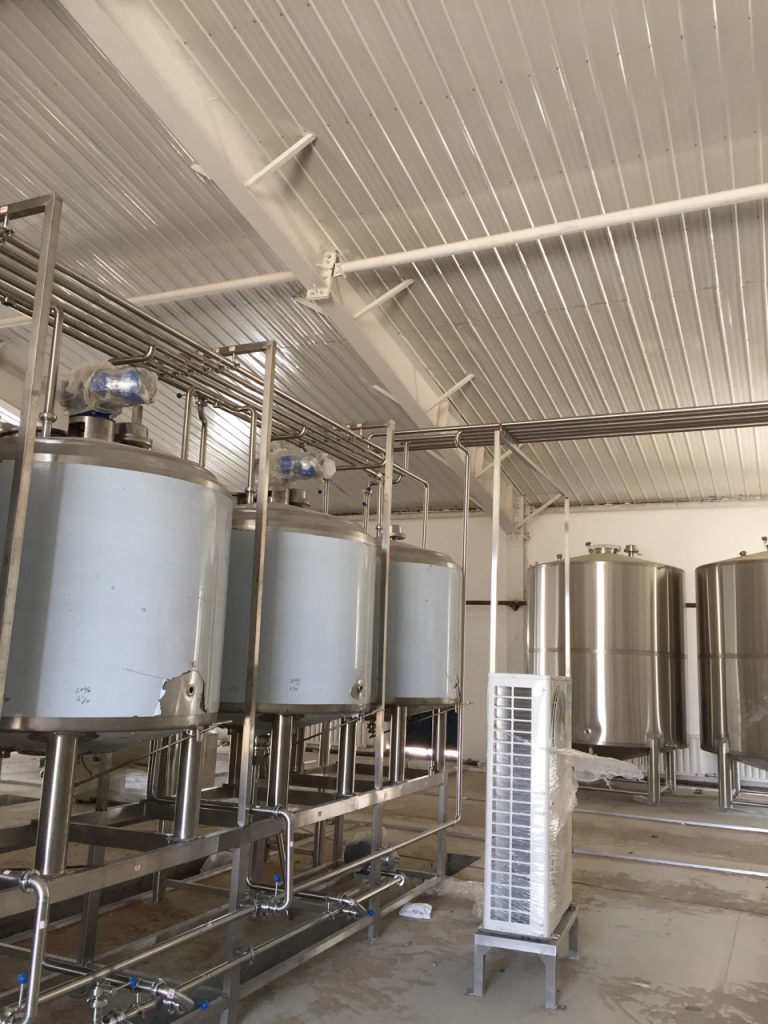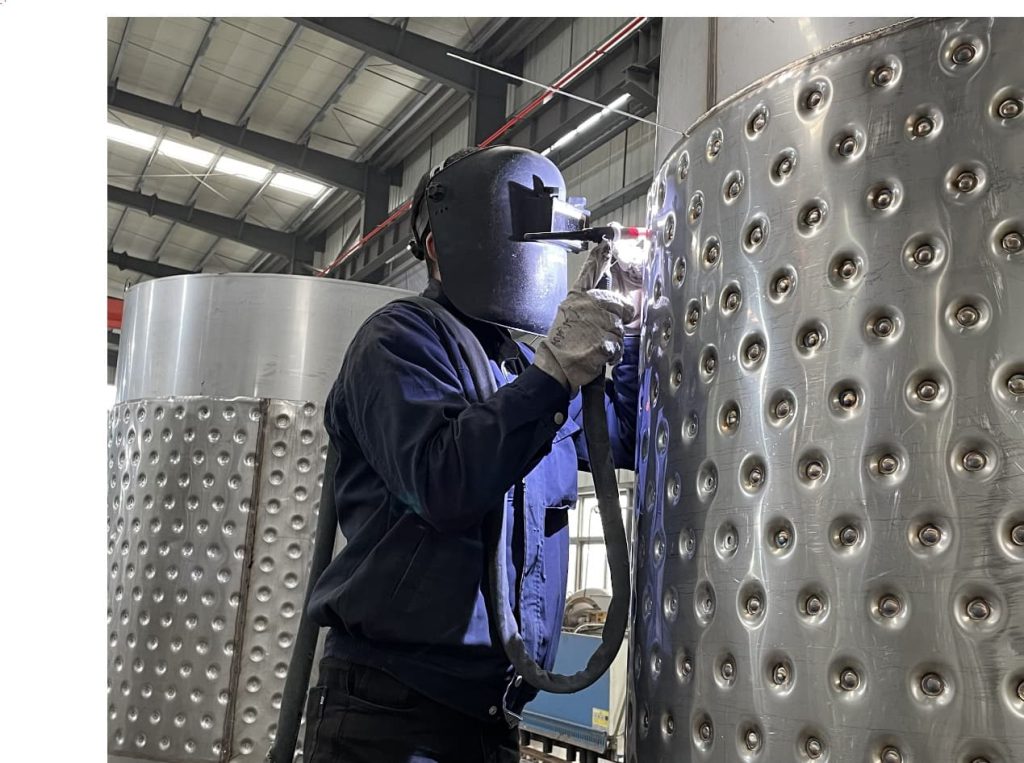導入

競争の激しい酪農の世界では、効率と品質が最も重要です。効率と品質の両方を大幅に向上できる重要な機器の 1 つが、ミルク冷却タンクです。ミルク冷却タンクは、ミルクが適切に冷却され、保管されることを保証することで、ミルクの品質、運用効率、および農場全体の生産性の向上につながります。このブログでは、ミルク冷却タンクへの投資が酪農場をどのように変えることができるかを探り、ミルクの品質維持、コスト削減、規制遵守など、さまざまな側面を取り上げます。
の役割 ミルクの冷却 酪農における
搾乳後の牛乳の鮮度と品質を維持するには、牛乳の冷却が不可欠です。適切に冷却しないと、細菌の増殖や酵素の活動により牛乳はすぐに腐ってしまいます。牛乳冷却タンクは、この作業に対応するために特別に設計されており、酪農業務の効率化に貢献するさまざまな利点を提供します。
牛乳の品質の維持
ミルク冷却タンクの主な機能は、ミルクの品質を保つことです。搾乳直後のミルクは、細菌の増殖を促す温度になっています。冷却タンクはミルクの温度を急速に 4°C (39°F) 以下に下げ、細菌の活動と酵素反応を遅らせます。これにより、ミルクの鮮度と品質が維持され、次の効果が得られます。
- 腐敗の低減: 適切な冷却により、牛乳が腐敗するリスクが最小限に抑えられ、牛乳が新鮮なまま消費または加工に適した状態を保つことができます。
- 味と食感がさらに良くなりました: より低い温度は牛乳の自然な味と食感を維持するのに役立ち、これは消費者の満足度と製品の品質にとって非常に重要です。
- 保存期間の延長: 冷却タンクは牛乳の品質を保つことで牛乳の保存期間を延ばし、廃棄を減らして収益性を高めます。
業務効率の向上
ミルク冷却タンクは、冷却プロセスを自動化し、ミルクの取り扱いを最適化することで、運用効率を高めます。これにより、いくつかの運用上の改善がもたらされます。
- 人件費の削減: 自動冷却システムにより、手作業による介入の必要性が減り、農場労働者は動物の世話や飼料管理などの他の作業に集中できるようになります。
- 合理化された牛乳処理: 冷却タンクは大量の牛乳を処理できるため、複数の牛の牛乳を同時に処理することが容易になります。この効率性により、搾乳作業をより効率的に管理できます。
- 一貫した品質管理: 自動化システムにより、牛乳が常に必要な温度に冷却され、人的ミスが削減され、均一な品質が維持されます。
財務上のメリット ミルク冷却タンク
牛乳冷却タンクに投資すると、酪農場にとって大きな経済的利益がもたらされる可能性があります。初期投資は多額になるかもしれませんが、長期的な節約と収益の増加はコストを上回る可能性があります。次に、経済的利点をいくつか挙げます。
腐敗によるコスト削減
ミルク冷却タンクの最も直接的な経済的メリットの 1 つは、腐敗の減少です。ミルクを最適な温度に保つことで、腐敗や廃棄の可能性が減ります。これにより、コストが削減されるだけでなく、より多くのミルクを販売できるようになります。
エネルギー効率
最新のミルク冷却タンクは、エネルギー効率を考慮して設計されています。従来の方法に比べてエネルギー消費量が少ない高度な冷却技術が採用されています。長期的には、エネルギー コストを大幅に節約できます。
牛乳価格の上昇
高品質の牛乳は市場で高値で取引されることが多いです。牛乳が常に新鮮で高品質であることを保証することで、買い手とより良い価格で交渉でき、収益の増加につながる可能性があります。
主な特徴と仕様 ミルク冷却タンク
| 特徴 | 説明 |
|---|---|
| 冷却方法 | 直接膨張、間接膨張、プレート冷却などのさまざまな冷却方法。 |
| タンク材質 | 一般的な素材には、耐久性がありお手入れが簡単なステンレス鋼が含まれます。 |
| 温度範囲 | 一般的な冷却タンクは 2°C ~ 4°C (36°F ~ 39°F) の温度を維持します。 |
| 制御システム | 高度なタンクには、デジタル温度制御、アラーム、リモート監視などの機能が搭載されている場合があります。 |
| 断熱タイプ | 断熱材のオプションには、温度維持に役立つポリウレタンフォームやグラスファイバーなどがあります。 |
| エネルギー源 | タンクは、モデルに応じて、電気、ガス、または複数のエネルギー源の組み合わせで駆動できます。 |
| 寸法 | 小規模農場向けの小型ユニットから工業用大型ユニットまで、さまざまなサイズをご用意しています。 |
| クリーニング機能 | 一部のタンクには、手作業による洗浄の労力を軽減する自動洗浄システムが搭載されています。 |
| 保証期間 | 保証期間はメーカーによって異なりますが、通常は 1 年から 5 年の範囲です。 |
| 追加機能 | オプションには、自動ミルクレベルセンサー、温度記録、農場管理ソフトウェアとの統合などが含まれます。 |
規制遵守と品質保証
罰金を回避し、良い評判を維持するためには、乳製品規制を遵守することが重要です。ミルク冷却タンクは、規制基準を満たし、以下の方法で品質保証を確実にするのに役立ちます。
健康基準を満たす
多くの地域では、牛乳の保管と取り扱いに関して厳しい規制があります。牛乳冷却タンクは、牛乳を必要な温度に保つことでこれらの基準に準拠するのに役立ち、潜在的な健康問題や法的問題を回避します。
正確な記録の維持
現代の冷却タンクの多くには、温度やその他の重要なデータを追跡するデジタル監視システムが装備されています。これらのシステムは、検査や監査の際に役立つ正確な記録を提供し、規制に準拠していることを証明します。
製品の安全性の向上
適切な冷却は製品の安全性にとって重要です。ミルク冷却タンクは有害な細菌や病原菌の増殖を防ぐことで、生産したミルクが安全に飲めるようにし、食中毒のリスクを軽減します。
インストールとメンテナンス ミルク冷却タンク

ミルク冷却タンクの最適なパフォーマンスを確保するには、適切な設置とメンテナンスが重要です。設置と維持に関する重要なヒントをいくつかご紹介します。
プロフェッショナルな設置
最適なパフォーマンスを得るには、ミルク冷却タンクを専門家に設置してもらってください。適切な設置には、タンクのセットアップ、ミルクパイプラインへの接続、冷却システムの調整が含まれます。専門家による設置により、タンクが効率的に動作し、将来的に問題が発生するリスクを最小限に抑えることができます。
定期メンテナンス
ミルク冷却タンクを良好な作動状態に保つには、定期的なメンテナンスが不可欠です。日常的な作業には次のものが含まれます。
- クリーニング: 汚染を防ぎ衛生を保つために、タンクを定期的に清掃してください。
- 検査: 摩耗や漏れの兆候がないか確認してください。
- コンポーネントチェック: 冷却コンポーネントと冷媒を検査して、正しく機能していることを確認します。
パフォーマンスの監視
現代のタンクの多くは、温度と冷却効率に関するデータをリアルタイムで提供するデジタル制御および監視システムを備えています。これらのシステムを使用してパフォーマンスを監視し、問題を早期に特定することで、タンクが引き続き効率的に動作し続けるようにします。
結論
投資する ミルク冷却タンク は、酪農場の効率と収益性を大幅に高めることができる戦略的な決定です。牛乳冷却タンクは、牛乳の品質を維持し、運用効率を改善し、財務および規制上のメリットを提供することで、あらゆる酪農事業にとって価値ある追加機能となります。そのメリットを最大限に引き出し、長期的な成功を確実にするには、適切な設置とメンテナンスが不可欠です。適切な冷却タンクを使用すれば、牛乳の品質が向上し、腐敗が減り、収益が増加し、最終的には酪農事業全体の成功に貢献できます。
よくある質問
Q:牛乳はどのくらいの温度で保存すればよいですか? 冷却タンク?
A: 細菌の増殖を防ぎ、鮮度を保つために、牛乳は 4°C (39°F) 以下の温度で保管する必要があります。
Q:ミルク冷却タンクはどのくらいの頻度で洗浄する必要がありますか?
A:汚染を防ぎ衛生を保つために、搾乳セッションのたびにミルク冷却タンクを洗浄する必要があります。
Q: ミルク冷却タンク 他の種類の液体にも使用できますか?
A:ミルク冷却タンクは乳製品専用に設計されています。他の液体に使用すると、性能や効率に影響が出る可能性があります。
Q:ミルク冷却タンクが適切に冷却されない場合はどうすればいいですか?
A: 冷媒漏れ、部品の故障、温度設定の誤りなどの潜在的な問題がないか確認してください。診断と修理については専門の技術者にご相談ください。
Q:どうすれば ミルク冷却タンク エネルギー効率は良いですか?
A: エネルギー効率の高いミルク冷却タンクを選択し、定期的にメンテナンスを実施し、パフォーマンスを監視して、最適なエネルギー使用を確保してください。

